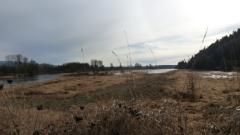forum
library
tutorial
contact

Columbia Estuary Land Purchase Benefits Salmon
by News SourcesKTVZ, January 24, 2012
|
the film forum library tutorial contact |

|
Columbia Estuary Land Purchase Benefits Salmonby News SourcesKTVZ, January 24, 2012 |
 PORTLAND, Ore. -- The Columbia Land Trust, Bonneville Power Administration and U.S. Army Corps of Engineers announced Tuesday the largest purchase of riverside habitat in the Columbia River estuary in nearly 40 years, permanently protecting essential refuge for salmon, steelhead and other wildlife.
PORTLAND, Ore. -- The Columbia Land Trust, Bonneville Power Administration and U.S. Army Corps of Engineers announced Tuesday the largest purchase of riverside habitat in the Columbia River estuary in nearly 40 years, permanently protecting essential refuge for salmon, steelhead and other wildlife.
The acquisition, which will benefit salmon from Oregon, Idaho and Washington as they migrate to the ocean, is the largest step yet in the estuary to mitigate the impacts of federal dams on the Columbia and Snake river systems.
The Columbia Land Trust on Monday completed the purchase of the 920-acre Columbia Stock Ranch on the south shore of the Columbia River near Goble, Ore., with $5.3 million in BPA funding. The purchase sets the stage for the Corps of Engineers to restore hundreds of acres of historic wetlands in the next few years to provide food and shelter for salmon migrating to and from the ocean.
The acquisition protects more estuary habitat for conservation than any other single purchase since the early 1970s.
"The size and ecological importance of this habitat set a new benchmark for habitat protection and is a key piece in an extensive fish refuge system in the lower Columbia River," said Glenn Lamb, executive director of the Columbia Land Trust. "In the last 10 years we have worked with about 60 landowners to conserve 9,100 acres of estuarine and tributary spawning and rearing habitat. BPA has been an important partner in many of these projects. The estuary is a particularly vital nursery for young salmon, and this project is the best demonstration yet of conserving and restoring the lands that make the estuary so valuable."
An independent panel of biologists identified the parcel as an especially valuable swath of historic tidal wetlands that if restored would boost survival of young salmon as they transition to saltwater. Some two-thirds of estuary wetlands have been lost over the last century, but recognition of their biological significance has encouraged restoration.
"Everything we learn tells us more and more that the estuary is very important to juvenile fish," said Ron Thom, a Pacific Northwest National Laboratory scientist specializing in ecosystem restoration who helps assess potential projects. "Restoration can create more habitat to support them. In general, the more opportunities for fish to access large, productive rearing and feeding habitats, the better the chances of young salmon gaining strength and ultimately surviving."
"I applaud the collaboration between the parties - the local landowners, the Estuary Partnership, the Land Trust and the federal agencies - in bringing this project into our Fish and Wildlife Program to help mitigate for the hydro system's effects on salmon and steelhead. Estuary projects benefit multiple populations and increase the benefits for the ratepayer dollars spent," said Joan Dukes, chair of the Northwest Power and Conservation Council.
"The Columbia Stock Ranch site offers a large area for contiguous restoration," said Elvon Childs, the Corps' Columbia Stock Ranch project manager. "We are designing the project so it maximizes benefits for salmonid habitat restoration with direct tidal connections to the Columbia River."
"Not since the early 1970s when the two lower Columbia River wildlife refuges were established has there been a single purchase of this magnitude purely for conservation," said Debrah Marriott, executive director of the Lower Columbia River Estuary Partnership. "The Deer Island area was once a rich network of forests, shrub scrub, wetlands, sloughs and floodplain lakes that provide critical shallow water areas for juvenile salmon resting and rearing as they make their way to the ocean. With this purchase and the restoration of this property, these essential habitats will once again become available to Endangered Species Act listed fish and other species."
Federal agencies are responsible for mitigating the impacts of federal hydroelectric dams on salmon as outlined by NOAA Fisheries' Biological Opinion. The mitigation includes new technology ensuring more fish pass dams safely and habitat restoration, with increasing focus on the estuary below Bonneville Dam.
"We've seen fish returning to other restored habitat within days, so large, contiguous properties such as this one should boost salmon survival even more," said Lorri Bodi, BPA vice president of Environment, Fish and Wildlife. "Healthy estuary habitat is like a Head Start program for salmon that makes them that much more likely to return to the Northwest to spawn as adults."
Management and restoration plans for the property will be developed with public input. Restoration work will also support the local economy and jobs. The restored habitat will benefit coho, chinook and chum salmon; steelhead; and cutthroat trout, as well as terrestrial wildlife such as black bear, elk and river otter.
Related Sites:
Columbia Land Trust
learn more on topics covered in the film
see the video
read the script
learn the songs
discussion forum
